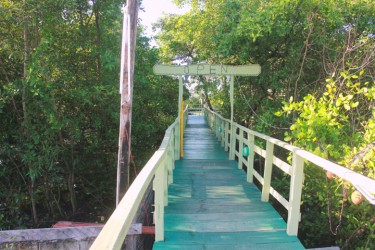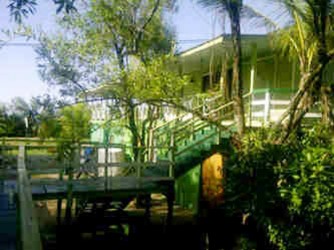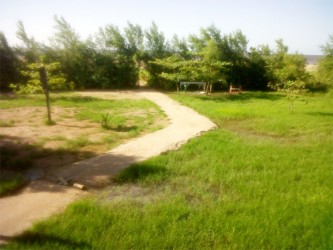While the Celina Resort, east of the Kitty pump station, remains closed until sometime in September its proprietor has opened another restaurant and bar a few metres east at another building.
Nestled among the trees and bushes on the foreshore, the new restaurant and bar would escape attention

except for a short wooden stairs over the seawall. It is unclear when the building was constructed as the thick mangroves prevent the eye from seeing through. Numerous questions have been raised as to how permission was granted for construction on this sensitive sea defence reserve.

Stabroek News was told by an employee that the building was commissioned three weeks ago and while management searches for an apt name for the establishment, it will just be called ‘Celina 2’ for now . The employee informed that the main location was closed for two months but did not go into details for the reason.
Reporters were greeted by a smiling DJ and three waitresses. An employee explained that the entity reflects a Hawaiian atmosphere and its interior design illustrates this.
There is a balcony around the building and customers have the choice of either sitting inside or outside.
The Celina resort has come in for much criticism by environmentalists as its construction on the environmentally sensitive area poses a risk to sea defences, mangroves and courida plants.
Former Chief Hydraulics Officer and Specialist Engineer for Sea Defences, Malcolm Ali had said that the Celina Atlantic Resort building violates the Sea Defence Act and permission for its construction should not have been granted.
Ali had stated in a letter to Stabroek News that he had designed and built that section of the sea defence in 1968, following massive erosion of the foreshore. He had explained that where Celina sits, to the north of the seawall next to the Kitty Pump Station, was the grouted boulder slope, below which has built up silt. The Celina building, he said, is built over this silt, which can disappear overnight by erosion, causing the building’s foundation to collapse and damaging the seawall.

Ali has said that on account of severe erosion on the East Coast during the late 1960s, Parliament on the advice of he and other engineers in the Hydraulics Division amended the Sea Defence Act, preventing construction of buildings and other structures in several areas of the coast landwards from 50 feet to 1000 feet from the centre line of the sea dam. He had also noted that only in rare cases is permission granted by the Sea Defence Board to build minor structures—for religious purposes—seaward of the sea dam, and the responsibility to remove same during an erosion cycle rests with the owners.
Engineer Bert Carter also previously opined that no one should be allowed to build any structure beyond the seawall, given the potential threat to sea defences while late engineer Melvyn Sankies said he thought the building was an obstruction. He explained that in the case of any emergency or disaster, full access is needed in that area.









